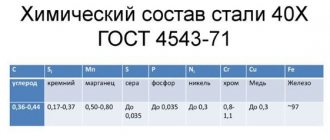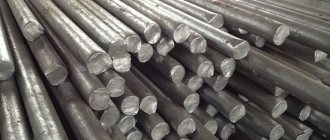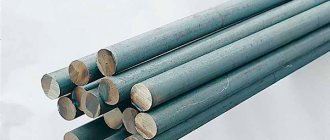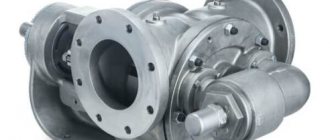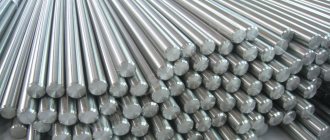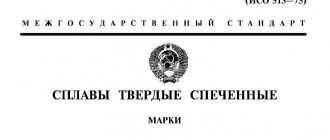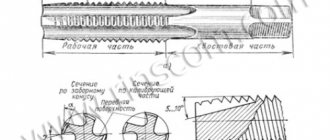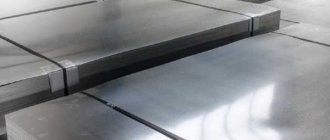GOST and other regulatory requirements for steel
The production of material of this brand is regulated by regulatory documents - a number of GOSTs, technical specifications “Shaped steel profiles of high precision. Technical conditions". (TU 14-11-245-88), OST “Structural steel blanks for mechanical engineering. General technical conditions". (OST 3-1686-90).
Information about GOSTs and other regulatory documents that were used in the production of 20X13 steel can be found in the document. This is a quality certificate of the metallurgical plant that smelted and delivered.
Main categories
The following classes of fittings are popular in Russia: A240, A400, A500C, AT800. Below we will look at them in detail.
A240 (AI)
Reinforcement of this type is made from carbon steels, which additionally contain small amounts of manganese, nickel, chromium, and copper. Brand A240 - smooth fittings. If the cross-sectional diameter is less than 12 millimeters, then A240 can be in the form of large coils held together with wire. Spare parts with a diameter of more than 12 millimeters are made in the form of separate rods of short length (up to 5 meters). The brand is used for the construction of small lightweight structures. It can also be used to reinforce small objects - compact columns, curbs, partitions, walls.
A400 (A-III)
A400 class rods have a round cross-section with a corrugated surface. Corrugation on spare parts appears due to small protrusions, which are located at an angle of 40-45 degrees relative to the central axis of the reinforcement. A400 is made from carbon steel, which includes a large number of filler components. The main additive component is manganese, which makes the alloy more durable and reliable. In addition to manganese, the alloy also includes other components - chromium, nickel, copper. The presence of stiffening ribs provides better adhesion of the A400 to the concrete composition.
Therefore, durable composite parts based on reinforced concrete are often made from the A400 brand - walls, floors, ceilings, inclined surfaces, vertical pillars, beams, bridges. Another area of application is road pavement reinforcement. Welding can be used to connect A400 parts to each other, but it is recommended to do butt welding using the butt welding method or using spot welding machines. Alternative welding technologies are less reliable, and the resulting structure will have low bending strength. This negatively affects the shelf life of the reinforced concrete product.
A500C
The A500C brand appeared on the Russian market relatively recently - in the 90s. Reinforcement of this type undergoes a number of auxiliary technological treatments (hot rolling, thermal hardening). These treatments significantly increase the physical properties of the material - elasticity, strength, stretching. Also, the A500C brand has poor contact with water and air, since it is chemically inert. Interestingly, grade A500C is smelted from ordinary steel containing an average amount of carbon and a minimum amount of alloying additives.
This makes the material cheaper to produce, which will be very useful for the builder. The A500C brand tolerates welding well, and can be joined using almost any welding method - overlap, butt, cross-overlay, and so on. The brand can be used for the construction of both large and small buildings based on concrete. These can be elements of a house or the entire house, bridges, hanging structures, medium-sized hangars, support poles, power lines. The only major drawback of the A500C is the deterioration of physical properties at low temperatures (below -30 degrees). Therefore, parts of this type are not recommended for use in the Far North.
AT800
The AT800 brand belongs to the class of heavy-duty reinforcements that have undergone hot rolling and thermomechanical hardening. The surface of the material is usually corrugated, although smooth varieties of the AT800 brand are also available. The brand is used for the construction of large massive structures based on reinforced concrete. These can be multi-story buildings, bridges, hangars, and so on. Thermo-mechanical hardening performs the following functions:
- Increasing ductility while maintaining the strength of the material (ductility increases by 20-30%).
- Increased fatigue strength, which allows spare parts to retain their shape even during long-term use.
- Improving anti-corrosion properties, minimizing the risk of cracking of the material upon contact with chemicals.
Areas of application of steel 20Х13
Due to its heat-resistant and other characteristics, ferritic chromium steel is widely used in the following areas:
- mechanical engineering;
- production of furnaces and turbine blades operating at high temperatures;
- production of parts with increased plasticity that are subject to shock loads, for example, hydraulic press valves;
- production of products exposed to precipitation, solutions of organic salts and other mildly aggressive environments;
- production of fasteners;
- production of whole-woven rings for various purposes;
- production of parts for compressor machines operating using non-containing gas;
- production of parts operating at low temperatures in aggressive environments;
- production of parts for aviation purposes.
Application
Steel 20x13 has been widely used for more than 100 years of service:
- Power engineering, production of furnace equipment, other areas of mechanical engineering.
- Manufacturing of blades for turbines experiencing heavy loads associated with pressure and elevated temperatures.
- Production of fittings for cracking devices for use at temperatures up to 500 degrees. WITH.
- Production of high strength fastener components with good corrosion resistance.
- Manufacturing of hardware: bolts, screws, etc.
- Production of products that are exposed to high humidity.
- Manufacturing of ring-shaped parts for use in various areas of industrial production.
- Production of products for use in aggressive chemical environments at low temperatures.
- Manufacturing of parts for compressors operating with nitrogen oxides – nitrous gases.
Heat treatment significantly improves the performance qualities of steel 20x13. To produce wear-resistant products and components, various improvements are made to the material, its structure and physical and chemical properties. Literature and sources used:
- Walter Tirler, Beuth Verlag. "International steel comparison: German / English" = "Internationaler Stahlvergleich: Deutsch / Englisch" (German) / Beuth Verlag GmbH.
- Lisochkin B.F. Kuznetsk steel.
- Kudrin V. A., Shishimirov V. A. Technological processes of steel production. — Rostov-on-Don: Phoenix, 2022.
- International Iron and Steel Institute
Technical characteristics of metal 20Х13
Metal of this grade has high manufacturability under conditions of plastic hot deformation. Recommended deformation intervals are:
- about 1100 degrees at the beginning;
- from 875 to 950 degrees at the end.
Heating for rolling or forging should be carried out gradually up to 780 degrees, and after deformation, slow cooling should also be used.
The softening heat treatment of this type of material is annealing at a temperature of about 800 degrees. Cooling with the furnace should be up to 500 degrees, and the final heat treatment-hardening should be carried out at a temperature of about 1000 degrees with oil cooling or outdoors with tempering for corrosion resistance and the required hardness.
The manufacturability of the material is possible both with hot and cold deformation. The steel has a martensitic class, and its critical points are as follows:
- A c1 = 820 degrees;
- A c3 = 950 degrees.
The microscopic structure of the metal in its quenched form includes martensites and carbides, and in the annealed form it is a mixture of carbide and high-chromium ferrite. If you increase the tempering temperature to 450 degrees, the strength is significantly reduced and the ductility of the material increases. But corrosion resistance indicators are also decreasing.
Cementation 20Х13
The answer to both questions is the separation of a cementite network along the grain boundaries. In addition, at 1050C there was strong grain growth.
The advantage of this steel in comparison with X12M steel is the absence of carbide heterogeneity in the structure of the material, which is one of the reasons for the reduced resistance to the fracture process. Quote from here (p. 47-48):
From there, s. 48-49:
There is conflicting information in the literature about the results of carburizing steels of type X13, which is associated with the use of different compositions of carburizers, temperature and time regimes of carburization and hardening. A study of the structure and properties of the surface layer of steel 20Х13 depending on the composition of the carburizer, carburization modes and subsequent hardening was presented. Wood activated carbon with the addition of sodium bicarbonate (NaHCO3 and Na2CO3) was used as the main carburizer. Cementation of samples made of steel 20Х13 was carried out at temperatures of 880С, 950С, 1050С with exposure for 1,2,4 and 6 hours at each of the carburization temperatures or after reheating to temperatures of 880С and 950С. Research has shown that the most active carburizer is with Na2CO3 additives. In this case, depending on the percentage of the activator, a dark layer may form on the surface of the samples, the depth of which is directly dependent on both the composition of the carburizer and the temperature of the saturation process. The uneven distribution of bicarbonate in activated charcoal can cause the formation of zones with a dark layer of up to 0.04 mm. The optimal activator content is from 10% to 15%. The possibility of the formation of a dark layer requires the production of products with an allowance for final processing. Cementation at a temperature of 1050C significantly accelerates the saturation process and makes it possible to obtain a deeper hardened layer with carbides. However, at this temperature, an austenitic sublayer with a carbide network is formed along the grain boundaries and significant grain growth occurs even when held for two hours. By using thermal cyclic treatment, which consists of repeated heating to a temperature of 850C and rapid cooling, it is possible to grind the grain and partially break the carbide network formed during carburization.
Cementation at a temperature of 950C is much slower, but grain growth and carbide precipitation along grain boundaries are not observed. After the saturation process, heat treatment should be carried out in order to obtain the necessary properties in the surface layer and across the cross-section of the product. The optimal hardening temperature, which ensures maximum hardness of the surface layer, is 880C, but the core does not have sufficient strength. To increase the strength properties of the product core, the quenching temperature should be increased to 950C. Thus, the results obtained made it possible to determine the carburization regime of steel 20Х13. Thus, to harden tools that do not require great strength, it is advisable to use carburization at 1050C, a hardening temperature of 880C; for tools operating under dynamic loads, carburization should be carried out at a temperature of 950C with direct hardening.
Foreign analogues
The need for metal-containing alloys that are resistant to heat is spreading everywhere, so different countries on different continents are setting up their own production of steels, often very similar in composition to their foreign counterparts. For steel 20Х13 there are the following analogues abroad:
- United States of America - 420 and S42000;
- Japan - SUS420J1;
- Europe - X20Cr13;
- China - 2Cr13.
Knowing these names, anyone will be able, regardless of their geographic location, to purchase a product made from the desired grade of steel in the nearest store.
Processing methods
Processing Features:
- It is better to cut workpieces in a hot-rolled state.
- Welding has no restrictions. It can be performed in different ways - CTS, ADS with protection from inert gases or flux, RDS.
- Forging is recommended to be carried out at heating up to 1280 °C. Forged parts should be cooled in air, without using water or oil.
The material lends itself well to stamping on industrial equipment.
Steel grade 20 - ferrous scrap metal. It does not contain expensive chemical elements. The production process is simple and does not require large expenses. Therefore, the cost of this alloy is quite low.
Physical properties of steel 20Х13
Density 7.76·103 kg/m3.
The value of the elastic modulus (E), thermal conductivity coefficient (λ), specific heat capacity (C), temperature coefficient of linear expansion (α) depending on temperature
| °C | E·10-4,N/mm2 | λ,W/(m K) | C 103, J/(kg K) | Temperature range, °C | α 106, K-1 |
| 20 | 22,3 | — | 0,441 | — | — |
| 100 | 21,8 | — | 0,462 | 0-100 | 10,1 |
| 200 | 21,2 | 24,8 | 0,525 | 0-200 | 10,4 |
| 300 | 20,4 | 26,7 | 0,567 | 0-300 | 10,9 |
| 400 | 19,3 | 27,2 | 0,630 | 0-400 | 11,4 |
| 500 | 18,4 | 27,7 | 0,693 | 0-500 | 11,9 |
| 600 | 17,2 | 28,1 | 0,777 | 0-600 | — |
| 700 | — | — | 0,966 | 0-700 | — |
Characteristics of the material: steel 20Х13.
| steel grade | steel 20Х13 |
| Steel substitute | steel 12Х13, steel 14Х17Н2 |
| Steel classification | Corrosion-resistant, heat-resistant steel |
| State Enterprise "Stalmash" supplies steel 20Х13 in the following types of rolled metal: round steel 20Х13 GOST 2590-2006 round hot-rolled steel sheet steel 20Х13 GOST 19903-74 hot-rolled sheet | |
| Application of steel 20Х13 | power engineering and furnace engineering; turbine blades, bolts, nuts, fittings for cracking units with a long service life at temperatures up to 500 degrees; martensitic steel |
Chemical composition in % of material steel 20Х13
| C | Si | Mn | Ni | S | P | Cr |
| 0.16 — 0.25 | up to 0.6 | up to 0.6 | up to 0.6 | up to 0.025 | up to 0.03 | 12 — 14 |
Temperature of critical points of material steel 20Х13
Ac1 = 820, Ac3(Acm) = 950, Ar1 = 780
Mechanical properties at T=20oC of material 20Х13.
| Assortment | Size | Eg. | sв | sT | d5 | y | KCU | Thermal change |
| — | mm | — | MPa | MPa | % | % | kJ/m2 | — |
| Sheet | 1 — 4 | Pop. | 500 | 20 | Holiday 740 - 800oC, | |||
| Sheet | 4 — 25 | Pop. | 500 | 20 | Holiday 680 - 780oC, | |||
| Forgings | up to 100 | 630 | 400 | 17 | 45 | 600 | ||
| Forgings | up to 200 | 630 | 400 | 16 | 42 | 550 | ||
| Forgings | up to 400 | 630 | 400 | 14 | 40 | 500 |
| The hardness of the material is steel 20Х13 after annealing, | HB 10 -1 = 126 - 197 MPa |
| The hardness of the material is steel 20Х13 after hardening, | HB 10 -1 = 241 MPa |
| Material hardness steel 20Х13, Forgings | HB 10 -1 = 197 - 248 MPa |
Physical properties of the material steel 20Х13
| T | E 10- 5 | a 10 6 | l | r | C | R 10 9 |
| hail | MPa | 1/Grad | W/(m deg) | kg/m3 | J/(kg deg) | Ohm m |
| 20 | 2.18 | 23 | 7670 | 588 | ||
| 100 | 2.14 | 10.1 | 26 | 7660 | 461 | 653 |
| 200 | 2.08 | 11.2 | 26 | 7630 | 523 | 730 |
| 300 | 2 | 11.5 | 26 | 7600 | 565 | 800 |
| 400 | 1.89 | 11.9 | 26 | 7570 | 628 | 884 |
| 500 | 1.81 | 12.2 | 27 | 7540 | 691 | 952 |
| 600 | 1.69 | 12.8 | 26 | 7510 | 775 | 1022 |
| 700 | 12.8 | 26 | 7480 | 963 | 1102 | |
| 800 | 13 | 27 | 7450 | |||
| 900 | 28 | |||||
| T | E 10- 5 | a 10 6 | l | r | C | R 10 9 |
Technological properties of the material steel 20Х13
| Weldability: | limited weldability. |
| Flock Sensitivity: | not sensitive. |
| Tendency to temper brittleness: | inclined. |
Foreign analogues of the material steel 20Х13 Attention! Both exact and closest analogues are indicated
| USA | Germany | Japan | France | England | European Union | Italy | Spain | China | Sweden | Poland | Czech |
| — | DIN,WNr | JIS | AFNOR | B.S. | EN | UNI | UNE | G.B. | SS | PN | CSN |
Designations:
| Mechanical properties : | |
| sв | — Short-term strength limit, |
| sT | — Limit of proportionality (yield strength for permanent deformation), |
| d5 | — Elongation at break, |
| y | — Relative narrowing, |
| KCU | — Impact strength, |
| HB | — Brinell hardness, |
| Physical properties: | |
| T | — Temperature at which these properties were obtained, |
| E | — Modulus of elasticity of the first kind, |
| a | — Coefficient of thermal (linear) expansion (range 20o - T), |
| l | — Thermal conductivity coefficient (heat capacity of the material), |
| r | — Density of the material, |
| C | — Specific heat capacity of the material (range 20o - T), |
| R | — Electrical resistivity, |
| Weldability: | |
| no limits | — welding is performed without heating and without subsequent heat treatment |
| limited weldability | — welding is possible when heated to 100-120 degrees. and subsequent heat treatment |
| difficult to weld | — to obtain high-quality welded joints, additional operations are required: heating to 200-300 degrees. during welding, heat treatment after welding - annealing |
Brand of steel and alloys
Features of welding material 20Х13
The type of steel in question can be welded well by such methods as;
- manual welding;
- electric arc;
- argon-arc automatic.
Expert recommendations state that when automatically welding this steel, it is better to use Sv-10X13 or Sv-06X14 wires. But for electric arc welding, fluxes of the AN 18 or AN 17 types are better suited. But if we are talking about manual electric arc welding, then you can use electrodes of the EF-X13 type together with wires similar to those used in automatic welding.
To prevent cold cracks from appearing in welded joints when welding parts with a thickness of 10 mm or more, as well as thinner ones with rigid fastening, it is necessary to use accompanying or preheating up to a temperature of 400 degrees inclusive. After welding work, the joints or products should be tempered, most often this is done at a temperature of about 700 degrees.
The weldability of this steel is of three types:
- without restrictions, when welding work is performed without heating and subsequent heat treatments;
- limitedly weldable metals that can be welded under heating conditions of approximately 100 degrees and which must necessarily be subjected to heat treatment;
- difficult-to-weld parts; in such cases, in order to obtain a high-quality connection, it is necessary to preheat up to 300 degrees and perform annealing as a heat treatment after welding.
These are the application features of such a material as steel 20X13. Now you will know under what conditions and how to apply and process it correctly.
Key features of steel 20Х13
This type of steel has limited weldability; functions such as heating the alloy or heat treatment are available depending on the welding method used, as well as the type and purpose of the structure.
Steel 20Х13 is used as a heat-resistant material at temperatures up to 550 degrees and as heat-resistant up to 700 degrees, respectively.
The main alloying element of this type of steel is chromium. It is thanks to him that it is resistant to corrosion when working in an oxidizing environment. Corrosion resistance is also explained by the presence of a very dense protective film on the steel. The highest degree of corrosion resistance of 20Х13 steel is achieved through heat treatment.
Substitutes
In such a widely demanded field as metallurgy, there cannot be interchangeable products. For any type of steel there is a substitute that fully or partially matches the original in its characteristics and composition. For steel 20Х13 there are the following substitute grades:
- 12X13 is a steel with a lower carbon content, which is somewhat compensated by a higher content of silicon and manganese.
- 14Х17Н2 is an alloy richer in various additives, characterized by a slightly higher carbon content and additional additions of titanium, copper and nickel. A similar grade of steel has better characteristics and, for example, the same steel sheet of this grade will be more preferable for the manufacture of something.
Decoding steel
So, let's start with the simplest thing. Correctly deciphering steel grades is a very useful skill, which you cannot do without if you often have to work with various alloys.
Since the Soviet naming system and GOST standards are still used in the domestic metallurgy, absolutely any steel grade is deciphered according to approximately the same principle. Steel 20Х13 is deciphered extremely simply:
- The number 20 (or 2 in some cases) indicates the amount of the main alloying element in any steel - carbon.
- The letter X means that the alloy contains at least chromium.
- The number 13 indicates the percentage of the previous chemical element.
After such a superficial analysis, based only on reading the steel grade, it becomes clear that this is technical steel with a carbon content (approximately 0.2%) and chromium (approximately 13%)
It is important to note that this information already sufficiently fully allows us to determine the characteristics and application of 20Х13 steel
Mechanical properties of steel 20Х13
Standardized mechanical properties at 20 °C
| GOST | Product type | Heat treatment mode for rolled products | N/mm2 (not less) | N/mm2 (not less) | % (not less) |
| GOST 5949-75 | Variety | Hardening 1000-1050 °C, tempering 660-770 °C | 650 | 440 | 16 |
| Ψ> 55%, =78 J/cm2 | |||||
| Hardening 1000-1050 °C tempering 600-700 °C | 830 | 635 | 10 | ||
| Ψ> 50%, >=59 J/cm2 | |||||
| GOST 7350-77 | The leaf is thick | Normalization or hardening at 1000-1050 °C, air cooling, tempering at 680-780 °C, furnace or air cooling | 510 | 375 | 20 |
| GOST 5582-75 | Thin sheet | Annealing or tempering at 740-800 °C | 490 | — | 20 |
| GOST 4986-79 | Ribbon | Annealing or tempering at 740-800 °C | |||
| δ = 0.2-2.0 mm | 490 | 16 | |||
| δ <0.2 mm | 490 | 8 |
Mechanical properties at low and elevated temperatures (rod, normalization at 1000-1020 °C, air cooling, annealing at 730-750 °C)
| °C | N/mm2 | N/mm2 | % | Ψ, % | J/cm2 |
| -40 | 780 | 590 | 23 | 57 | 50 |
| -20 | 740 | 570 | 21 | 59 | 59 |
| 20 | 720 | 520 | 21 | 65 | 66-175 |
| 300 | 555 | 400 | 18 | 66 | 200 |
| 400 | 530 | 405 | 16 | 58 | 205 |
| 450 | 495 | 380 | 17 | 57 | 240 |
| 500 | 440 | 365 | 32 | 75 | 250 |
| 550 | 350 | 285 | 36 | 83 | 223 |
Features of steel
20x13 has a density of 7670 kgm3. The melting point is about 1600 ºС. Elastic Young's modulus is 2,000 MPa. Conducts heat well. The thermal conductivity coefficient fluctuates around 23-28 W (m*C). It has a low ability to pass current. The electrical resistivity is on average 800 Ohm*m. Magnetic.
The tensile strength is 610 MPa. Hardness - about 28 units on the Rockwell scale. 20x13 begins to deform already at a load of 500 MPa. Preliminary heat treatment allows you to increase the mechanical properties by 1.5-2 times. For comparison, after quenching and tempering, high quality structural steel 45 has a strength of 400 MPa.
Steel 20x13 is quite ductile. The relative elongation is 23%, and the contraction is 65%. Works well under alternating load conditions. The endurance limit is 500 MPa. Steel is heat resistant. Its mechanical properties remain unchanged at an ambient temperature of 600 ºС.
Grade 20x13 is characterized by increased resistance to corrosion. It performed well in mildly aggressive environments: fresh and river water, steam. Not resistant to most acids, alkalis, and sea water.
Heat treatment
Steel 20x13 has improved technological properties. It can be processed well by both cutting and pressure. Not floc sensitive. Has a slight tendency to temper brittleness. 20x13 belongs to the first group of weldability. Welding is carried out without preheating. The seam is thus strong and dense.
Heat treatment for steel 20x13 is the following sequence of actions:
- Normalization at 1000-1200 ºС, then vacation at 730-750 ºС. The ultimate strength of such steel at the output is 710 MPa.
- Hardening at 1050 ºС followed by uniform cooling in air. The final strength is already 1600 MPa.
What are the advantages and disadvantages of the material?
The pros and cons of the 20X13 alloy, the possibility of its use are taken into account at the stage of designing mechanical engineering products. Its main advantages are:
- heat resistance;
- low thermal conductivity;
- high corrosion resistance;
- a combination of qualities - hardness, plasticity, viscosity.
A large percentage of chromium and carbon content in products is the cause of the main problem that arises when using the alloy - low weldability. For its high-quality implementation, special heat treatment of products is required.
Technological features of the alloy
The properties that steel grade 20x13 exhibits during processing are high-class technological characteristics. They appear when processed using cutting and pressure methods.
The alloy is characterized by weak flake sensitivity, that is, a tendency to the appearance of flakes. These are defects in alloy steels, which are visible at a fracture as spots or flakes, but during transverse microsection they appear as cracks. Reduces the strength of high-quality steels.
There is a certain tendency towards temper brittleness - a decrease in the ductility of steel after hardening, when tempering occurs at temperatures of about 300-400 degrees. WITH.
Welding 20x13 can take place without preheating; the steel belongs to weldability group 1.
Carrying out heat treatment
The high carbon content in the alloy determines such features as difficulty in welding and the possibility of improving the quality of the metal material by obtaining martensite during hardening.
When heat treating steel, emphasis can be placed on the following points:
- Hardening 20x13 takes place at a temperature 100 degrees higher than the thousand-degree mark. This is predetermined by the heat resistance of the alloy. Such processing can only take place under special conditions of metallurgical production.
- Forging is carried out by heating the material to 780 degrees. C. Heating is carried out slowly and gradually, this is due to the possibility of structural deformations that must be avoided.
- Annealing requires a thermal regime of about 800 g. C. Cooling is carried out periodically to improve the quality of the alloy.
- After hardening, cooling is possible in various environments. For example, outdoor cooling. New technologies make it possible to connect the cooling method in oil baths. It allows you to uniformly reduce the temperature even for large parts or products. However, there are costs: sometimes situations arise when the oil catches fire and smokes. The technology is applicable only in specialized production facilities with good ventilation.
Changing the temperature of the holiday, increasing it to 450 gr. S., it is possible to improve the ductility of steel. But this occurs due to a decrease in the hardness of 20x13 and the corrosion resistance of the alloy.
Typically, heat treatment is carried out in two stages:
- The normalization process takes place at very high temperatures - about 1000-1200 g. C. Followed by holiday at a thermal regime of 730-750 g. WITH.
- Hardening 20x13 is carried out when it reaches 1050 g. C., then the alloy is cooled in the open air.
The first stage makes it possible to reach a tensile strength of 710 MPa; at the second stage, a value of 1600 MPa is achieved.
Chemical composition
In many ways, 20x13 steel resembles its analogues, which also contain a large amount of chromium. The chemical composition is represented by a combination of the following substances:
- Carbon largely determines the hardness and strength of the material, as well as the degree of weldability. In the case under consideration, the carbon concentration can vary from 0.16 to 0.25%.
- Chromium is considered the main alloying element. About 12-14% of this chemical is added to the alloy composition. It is chromium that determines heat resistance and corrosion resistance.
- Manganese and nickel are not the main elements of the alloy in question; their concentration is no more than 0.6%.
Almost all metals contain phosphorus and sulfur. These chemical elements are present in the composition at a concentration of no more than 0.03%.
Stainless steel sheet 20X13
Foreign manufacturers also produce alloys with similar chemical compositions. For example, the Japanese analogue of steel 20x13 was called SUS420J1, the French alloys z20c13 and X20Cr13.
General characteristics of the alloy
The main alloying element in the production of grade 20x13 (the characteristics of steel largely depend on the concentration of chemicals in the composition) was chromium. Its addition to the metal composition is carried out over a long period. The main characteristics of plastic are as follows:
- Limited degree of weldability. The metal in question is characterized by a low degree of machinability. In most cases, the material is heated to increase the degree of weldability.
- Heat resistance and low thermal conductivity are properties that significantly expand the range of the material under consideration. Corrosion-resistant, heat-resistant steel 20X13 can be operated at temperatures up to 700 degrees Celsius. Increasing the temperature to higher levels leads to a significant decrease in the properties of the material: hardness, resistance to deformation, and others.
- Hardness is maintained at a level of 126-197 MPa, depending on whether heat treatment was carried out.
- The structure is prone to temper brittleness; it is possible to carry out cutting processing.
Mechanical properties of steel 20Х13 at different temperatures
The main characteristics of the alloy determine the possibility of its use in the manufacture of a wide variety of products. If necessary, they can be improved by heat treatment, for example, hardening or annealing.
Compound
20x13 is corrosion-resistant and heat-resistant grade. The basis of its phase structure is represented by martensite. The brand has a metallic luster with a greenish tint characteristic of this class.
The chemical composition is regulated by the state standard GOST 5632-72, according to which 20x13 steel consists of the following elements:
- Carbon occupies 0.16-0.25% of the total composition. The content of the element greatly affects the strength and technological characteristics of steel. Iron carbides have increased hardness, and they also make it possible to strengthen steel through heat treatment. The reverse effect of such alloying is a deterioration in ductility and weldability.
- Chromium 12-14%. Increases the wear resistance of steel due to the formation of chromium oxides on its surface. In addition, it has a beneficial effect on the ability of the metal to thermally harden and increases resistance to corrosion. Steels alloyed with chromium better withstand loads at elevated temperatures.
- Silicon (up to 0.6%) and manganese (up to 0.6%) are mandatory additives for steel. They are the main deoxidizers and help remove oxygen from its composition. In addition, these components have a good effect on technological properties, such as ductility and weldability. Manganese, among other things, has a positive effect on surface cleanliness.
- Nickel (up to 0.6%). Its main purpose in alloys is to increase heat resistance. But it is worth noting that its content in 20x13 is insignificant to somehow noticeably affect its characteristics.
- Sulfur (up to 0.0025%) and phosphorus (up to 0.03%) are harmful impurities that significantly reduce the strength properties of steel and are responsible for the occurrence of such an effect as brittleness. Sulfur also increases the alloy's tendency to become red-brittle, which means an increased risk of cracking during pressure treatment. Their inclusion in the alloy is inevitable due to the imperfection of the smelting technology and the purity of the chemical composition of the initial charge.
- The rest of the composition is iron.
The most common structural steels
All iron-based steels belong to and have numerous classifications. It is produced according to various parameters: chemical composition, purpose, content of harmful elements, strength and flexibility, and many others. Structural - have become the most common in use. Some of them have universal properties and are interchangeable.
20 belongs to the medium-carbon class and has a ferrite-pearlite structure. The steel is of high quality, i.e. it has a reduced content of harmful elements: sulfur and phosphorus. No restrictions on weldability. The optimal combination of strength and ductility makes it simply a universal material for the production of rolled pipes and parts subjected to subsequent thermomechanical and thermochemical processing (cementing, galvanizing and chrome plating).
20Х13 (2Х13)
- Products made of steel 20Х13 (2Х13) in stock: Circle
- Sheet
- Band
- Square
- Ribbon
- Hexagon
- Forging
Steel 20Х13 (02Х13, 2Х13, EZh2) chromium, corrosion-resistant, heat-resistant, martensitic class
Substitutes: Steel 12Х13, Steel 14Х17Н2
Steel 20X13 is used: for the manufacture of steam turbine blades operating at temperatures up to +580°C; valves, bolts and pipes; parts with increased plasticity, exposed to shock loads and operating at temperatures up to 450-500 ° C; products exposed to mildly aggressive environments at room temperature; solid rolled rings for various purposes; various aircraft parts (carburetor needles, bushings, aircraft gears, parts of direct fuel injection equipment and compressor blades, heat-treated for HRC hardness
The main purpose of 20x13 is all kinds of components and parts for power engineering. This includes elements of turbine units and furnaces, fittings for cracking units, fastening joints operating at a temperature of 550 ºС.
Rating: 0/5 — 0 votes
Properties
Technological
- Pressure treatment temperature: initial value - 1260, final value - 750. Workpieces with a cross-section of 200 mm are cooled at a comfortable temperature of 22–20 ° C, and those with a cross-section of 202–710 mm are annealed at low temperatures.
- Cutting - Kv tv.spl = 1.3 and Kv b.st = 1.7 in the hot-rolled position has HB 131 σв = 460 megapascals.
- The tendency of steel to be damaged by flakes (defects inside) is insensitive. Decrease in ductility of hardened alloy steel is not prone.
Physical
Thermal conductivity number, the amount of heat passing during a unit of time through a unit of substance at a temperature of Celsius:
| Steel | Twenty | One hundred | Two hundred | Three hundred | Four hundred | Five hundred | Six hundred | Seven hundred | Eight hundred | Nine hundred |
| 20X | 216 | 214 | 198 | 192 | 181 | 173 | 165 | 142 | 133 | — |
Expansion number when exposed to heat, test temperature in Celsius:
| 20–100 | 20–200 | 20–300 | 20–400 | 20–500 | 20–600 | 20–700 | 20–800 | 20–900 | 20–1000 |
| 11,5 | 11,9 | 13,4 | 13,8 | 13,9 | 15,0 | — | — | — | — |
Ratio of heat capacity to mass joule/(kilogram × kelvin), temperature in degrees Celsius:
| 20–100 | 20–200 | 20–300 | 20–400 | 20–500 | 20–600 | 20–700 | 20–800 | 20–900 | 20–1000 |
| 496 | 507 | 524 | 536 | 566 | 587 | 625 | 706 | — | — |
Number of normative forces of plasticity, elasticity E, gigapascal, temperature in degrees Celsius:
| Steel | Twenty | One hundred | Two hundred | Three hundred | Four hundred | Five hundred | Six hundred | Seven hundred | Eight hundred | Nine hundred |
| 20X | 215 | 212 | 197 | 194 | 180 | 170 | 164 | 142 | 132 | — |
Modulus of plasticity power with imbalance per rotation G, gigapascal, temperature in degrees Celsius:
| Steel | Twenty | One hundred | Two hundred | Three hundred | Four hundred | Five hundred | Six hundred | Seven hundred | Eight hundred | Nine hundred |
| 20X | 84 | 82 | 78 | 75 | 72 | 66 | 63 | 57 | 51 | — |
Steel production
However, in its original form, steel is not very suitable for use, so metallurgical plants not only smelt the alloy, but also give it a certain shape. In this way, several goals can be achieved at once:
- Formed steel is easier to store.
- It is much easier to transport.
- Buyers know in advance which form factor of the purchased product they prefer.
For steel 20Х13 GOSTs provide several molding options:
- Rods of various calibers.
- Steel strip.
- Steel tape.
- Steel sheet of various thicknesses.
- Forging.
- Pipes of various diameters.
- Steel wire.
Steel 440С
Now we come to the most interesting part. 440C is an American chromium steel, one of the most balanced for knife production since the second half of the 1960s. For a long time it was considered the best in the world, until modern high-tech alloys came to replace it, which is a plus for the average user: with progress, knives from S-shka have become more affordable. It is recognized quite simply, the manufacturer is unlikely to think about it
not to mention that the blade is made of one of the best steels in the world. Look for “440C” engravings.
Compared to 440A and B, the C-shka is more difficult to produce, which makes it more expensive, giving a number of advantages, the main one of which is maintaining sharpness. To dull such a blade, you need to specifically cut metal cables and open a lot of tin cans, which is important both on long hikes and in everyday conditions. Hardness 440C is significantly higher than the previous two, with some hardening it reaches 60 HRC units, but the average value fluctuates around 58. Naturally, it cannot be called ideal, and with the appearance of a number of advantages, a number of shortcomings have appeared that cannot be called critical, but will be kept silent wrong. Steel is less resistant to corrosion and after contact with sea water, the knife must be washed and then dried, otherwise in the morning you may get a surprise in the form of rusty spots, which can be removed without any problems, but once you start the process, you will have to resort to special means. Fortunately, nowadays it is not difficult to find such liquids. The next drawback is the sharpening process, it is more labor-intensive compared to the two previous steels, but the result is worth it. The Soviet analogue is 100X18 and 95X18 (there are still disputes about the latter and many do not agree with this statement. As they say: How many people, so many opinions).
What tasks can a blade made of this material cope with? Almost everyone. In order not to describe it for a long time, I will say this: If you need a good knife for every day, but do not want to go into details, then take it, you will not regret it, it will serve you faithfully.
Steel 440C: advantages and disadvantages
- One of the most balanced knives in the world
- Hardness 58-60 HRC
- It has been on the market for a long time, the vagaries and subtleties of care are known
- Holds an edge perfectly
Other brands from this
Please note that this information about the 20X13 brand (another designation 2X13) is provided for informational purposes. The parameters, properties and composition of real material grade 20Х13 (another designation 2Х13) may differ from the values given on this page. More detailed information about grade 20Х13 (another designation 2Х13) can be found on the information resource Brand of steel and alloys. You can check with our managers for information about the availability, delivery times and cost of materials. If you find inaccuracies in the description of materials or errors found, please inform the site administrators using the feedback form. Thanks in advance for your cooperation!
Change of structure by thermochemical treatment
The same brand can change its characteristics through heat treatment. Steel grade 20 has good plastic characteristics, so products from it are produced by several methods: casting, cold or hot rolling or drawing. After parts are produced by casting, chemical-thermal treatment can be applied to them. The purpose of this procedure is to obtain a hard, wear-resistant layer that is resistant to corrosion, and a plastic, soft middle.
To do this, the finished part is placed in an appropriate environment (covered with a dry carbon-containing substance, placed in a gaseous or liquid environment), and then kept from several hours to 1.5 days at high temperature. parts should be completed by this moment, since after thermochemical treatment the product will already have its final structure. The element saturates the top layer of the product (from 0.3 to 3.0 mm), accordingly improving its structure and properties.
Depending on the substance used, the treatment is called: cyanidation (zinc coating), carburization (carbon), chrome plating (chrome). Carbon imparts strength, zinc imparts corrosion resistance, and chromium, in addition to all of the above, makes the surface mirror-like.
GOSTs and other standards for steel 20Х13
Today there are the following standards for this type of steel:
- forged steel in square and round shapes;
- wire based on heat-resistant and high-alloy steel;
- cold-worked rods processed on the basis of corrosion-resistant steel;
- forgings based on steels of this type and their alloys;
- thin-sheet and corrosion-resistant rolled products, characterized by heat resistance and heat resistance;
- highly alloyed and corrosion-resistant materials and their alloys;
- graded and calibrated metal, corrosion-resistant, heat-resistant and heat-resistant;
- forged and hot-rolled strips;
- round materials with special surface finishing;
- hot-rolled steel bars of round and square shapes;
- round calibrated metal;
- forged hot-rolled strips based on tool metal;
- calibrated square metals;
- hexagonal calibrated rolled products;
- forged metal round and square;
- highly alloyed materials and their alloys, characterized by corrosion resistance, heat resistance and heat resistance;
- hot-rolled strip bars based on steel material;
- graded and calibrated metal, resistant to corrosion, characterized by heat resistance and heat resistance;
- long hot-rolled hexagonal steel;
- steel high-precision shaped profiles;
- blanks based on structural material for use in the mechanical engineering industry.
Sources
- https://svarkaipayka.ru/material/stal/tehnicheskie-harakteristiki-legirovannoy-stali-20h13.html
- https://stanok.guru/stal/stal-20h13-klyuchevye-harakteristiki-i-osobennosti-metalla.html
- https://VFront.ru/o-materialah/stal-20h13.html
- https://intehstroy-spb.ru/spravochnik/stal-20h13-i-ee-osobennosti-harakteristiki-i-ispol-zovanie.html
- https://FB.ru/article/449472/stal-h-harakteristiki-primenenie-i-analogi
[collapse]
Steel 20Х13 - chromium stainless steel - Foundries of Russia
Classification of chromium stainless steelsSteel 08Х13Steel 12Х13Steel 30Х13
Steel 40Х13
Application of steel 20Х13
Steel 20Х13 is used in the manufacture of products for work in mildly aggressive environments:
- atmospheric conditions other than sea;
- aqueous solutions of salts of organic acids at room temperature;
- solutions of nitric acid of weak and medium concentrations at moderate temperatures, etc.
Steel 20X13 is used in cases where products must have sufficiently high strength, as well as high ductility and toughness. 20X13 steel can be welded satisfactorily.
Steel 20X13 is also used as a heat-resistant material at temperatures up to 450-550 °C and as a heat-resistant material - up to 700 °C.
Chemical composition of steel 20Х13
Steel 20Х13 is included in steel type Х13 along with steels 08Х13, 12Х13, 30Х13 and 40Х13. It occupies its own range in carbon content - from 0.16 to 0.25%, the amounts of other alloying elements and impurities are the same as in other steels of the X13 type (Table 1).
Table 1 - Chemical composition of steel 20Х13 according to GOST 5632-72
Steel class 20Х13 according to GOST 5632-72
According to the GOST 5632-72 classification, steel 20Х13 belongs to the martensitic class.
Transformations and microstructure of steel 20Х13
- When annealed steel 20Х13 is heated, the polymorphic alpha-gamma transformation occurs in it in the temperature range from 820 °C (Ac1) to 950 °C (Ac3). The temperature of point Ar1 is 780 °C.
- During isothermal holding or slow cooling in the range of 800-550 °C, austenite decomposes into a ferrite-carbide mixture.
This ferrite-carbide mixture consists of high chromium ferrite and Cr23C6 type carbide. - When 20Х13 steel is rapidly cooled, a martensitic transformation occurs in it. The temperature at which the martensitic transformation begins is 220 °C.
- With an increase in tempering temperature, there is a significant decrease in strength with an increase in ductility, as well as a decrease in corrosion resistance.
Steel range 20Х13
The following products are produced from steel 08Х13:
- thick sheet according to GOST 7350-77;
- thin sheet according to GOST 5582-75;
- tape and roll according to GOST 4986-78;
- long products according to GOST 5949-75;
- hot-deformed pipes according to GOST 9940-81;
- cold-deformed and heat-deformed pipes according to GOST 9941-81;
- wire according to GOST 18143-72.
Mechanical properties of steel 20Х13
The mechanical properties of steel 20Х13 in various types of products are presented in Table 2.
Table 2 - Mechanical properties of steel 20Х13 at 20 °С
The effect of decreasing and increasing temperature on the mechanical properties of a rod made of steel 20X13 after normalization from 1000-1020 °C and tempering at 730-750 °C is shown in Table 3.
Table 3 - Mechanical properties of steel 20Х13 at low and elevated temperatures
Corrosion resistance of steel 20Х13
Steel 20Х13 is highly resistant to atmospheric conditions (except for the sea atmosphere), river and tap water.
Special properties of steel 20Х13
For parts operating at elevated temperatures for a long time, the maximum operating temperature is 450-475 °C, for short-term operation - 500-550 °C.
The density of steel 20Х13 is 7.76 g/cm3.
Heat treatment of welds of steel 20Х13
After welding, tempering of welded joints or products is carried out. The tempering temperature depends on the level of mechanical properties required. Tempering at 680-760 °C is most often used.
Technological parameters of steel 20Х13
Steel 20Х13 has good processability during hot plastic deformation. The temperature range of hot plastic deformation ranges from 1100 to 875-950 °C. Heating for rolling and forging to 780 °C is carried out slowly. After hot deformation, slow cooling is used.
For steel 20Х13, softening annealing is usually used at 750-800 °C with cooling in a furnace to 500 °C. Final heat treatment - hardening from 950-1000 °C with cooling in oil or air and tempering to a given hardness and corrosion resistance.
